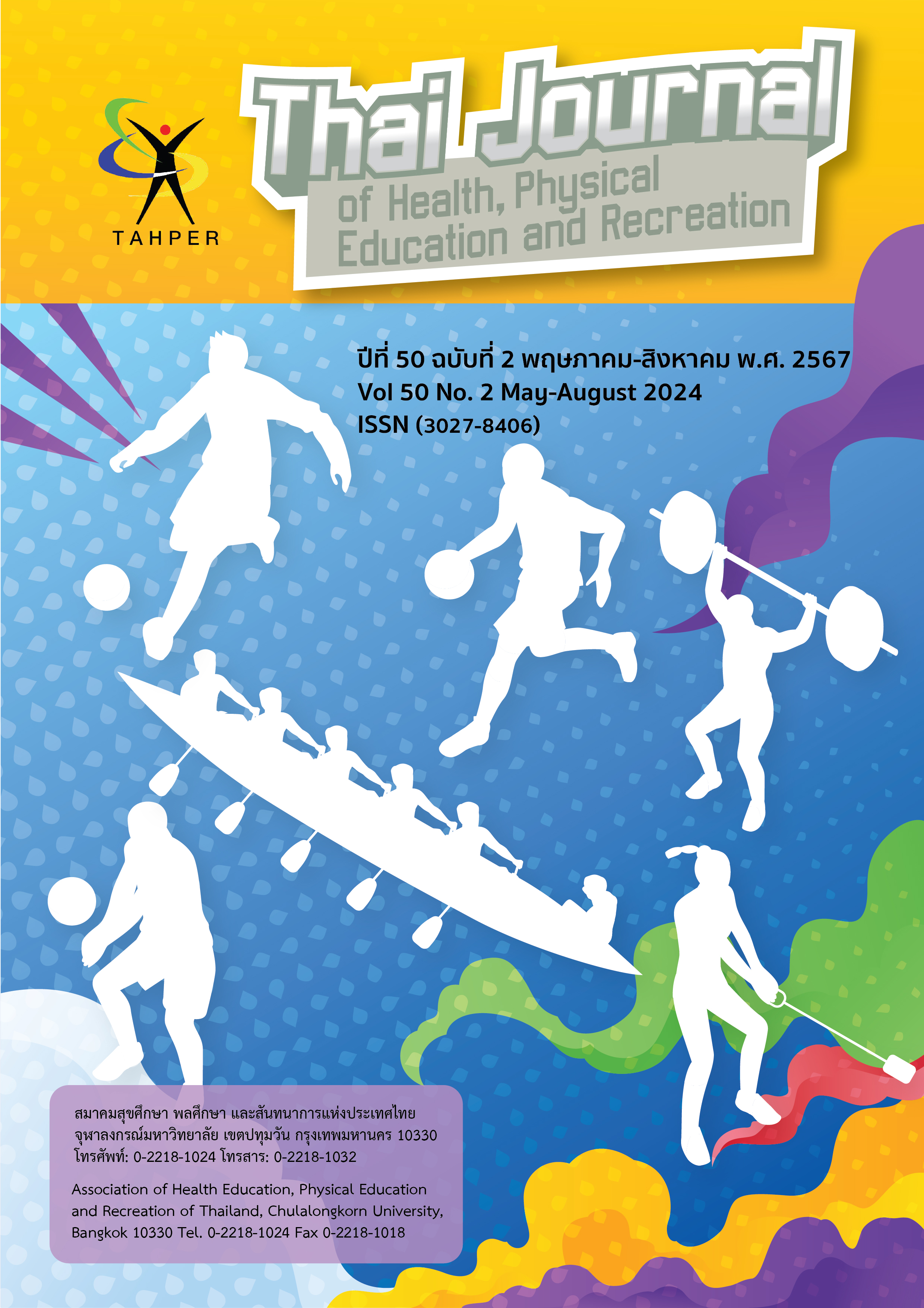The Effect of a Comparison of Plyometric Training Program and Body Weight Training Program on Leg Muscle Power and Speed in the 50-Meter Breaststroke of Swimming Athletes at Bangkok Sports School
Main Article Content
Abstract
This research aims to compare the effect of a plyometric training program and a body weight training program on leg muscle power and speed in the 50-meter breaststroke of swimmers at the Bangkok Sports School. The population consisted for 30 swimmers under the Bangkok Sports School by choosing a specific for 20 swimmers, divided into 2 groups by each groups for 10 swimmers. Experimental group 1 and experimental group 2 trained would be training for 2 hours per day and 3 days per week total 8 weeks. The research method is Plyometric training program, the body weight training program had an IOC value of 0.95, The frog swimming skill training program had an IOC value of 0.97, The leg strength was tested with the standing long jump test and the speed test in the 50m brackish swimming test. And for the analysis method in this research is statistics Mean Standard Deviation, pre and post trials by week 4 and week 8 of experimental group 1 and experimental group 2 with statistical t-test and Wilcoxon signed rank test. Difference between experimental group 1 and experimental group 2 after 8 weeks of training using Man Whitney u test.
The result of research shown that the leg strength and 50-meter breaststroke speed in groups of 2 experimental group was no difference and for the leg strength and 50-meter breaststroke speed between groups of 2 experimental after training in week4 and week8, there was no difference. For swimming speed was decrease mean time for both groups. Experimental group 1 had mean time less than experimental group 2 and for leg muscle strength both experimental groups was increase.
Article Details

This work is licensed under a Creative Commons Attribution-NonCommercial-NoDerivatives 4.0 International License.
Critical thinking in journals is the right of the author. The Association of Health Education, Physical Education and Recreation of Thailand is not always required, to create diversity in ideas and creativity.
ความคิด ข้อวิพากษ์ในวารสารเป้นสิทธิของผู้เขียน สมาคมสุขศึกษา พลศึกษา และสันทนาการแห่งประเทศไทยไม่จำเป็นต้องเห็นชอบด้วยเสมอไป เพื่อให้เกิดความหลากหลายในความคิดและความสร้างสรรค์
References
กระทรวงศึกษาธิการ. (2552). หลักสูตรแกนกลางการศึกษาขั้นพื้นฐาน พุทธศักราช 2551. กรุงเทพมหานคร: โรงพิมพ์ชุมนุมสหกรณ์การเกษตรแห่งประเทศไทย.
กอบบุญ แดงสุวรรณ. (2564). ผลของการฝึกความแข็งแรงและพลังของกล้ามเนื้อขาด้วยน้ําหนักตัวที่มีต่อความสามารถในการรีบาวด์กีฬาบาสเกตบอลของนักกีฬาโรงเรียนสุคนธีรวิทย์จังหวัดนครปฐม. วารสารสุขศึกษา พลศึกษา และสันทนาการ, 47(1), 40-48.
เจริญ กระบวนรัตน์. (2561). วิทยาศาสตร์การฝึกสอนกีฬา (2 ed.). กรุงเทพมหานคร: สินธนาก๊อปปี้เซ็นเตอร์.
ถาวร กมุทศรี. (2560). การเสริมสร้างสมรรถภาพทางกาย. กรุงเทพมหานคร: มีเดียเพรส.
สมาคมกีฬาว่ายน้ำแห่งประเทศไทย. (2564). จัดลำดับนักกีฬาว่ายน้ำประเทศไทย. สืบค้นเมื่อ 11 มีนาคม 2564, จากhttp://swimming.or.th/Index/HomeRanking?Distance=1&SwimmingTypeDetailId=2
สุคนธ์ อนุนิวัฒน์. (2562). ผลของการฝึกด้วย ที อาร์ เอ็กซ์ และการฝึกด้วยน้ำหนักของร่างกายที่มีต่อความแข็งแรงอดทนของกล้ามเนื้อ. วารสารสุขศึกษา พลศึกษา และสันทนาการ, 45(1).
ุธิดา เจริญผล. (2554). ผลของการฝึกพลัยโอเมตริกบนบกและในน้ำที่มีต่อพลังระเบิดของกล้ามเนื้อขาและความเร็วในการว่ายน้ำท่ากบระยะทาง50เมตรของนักกีฬาว่ายน้ำชาย. (ปริญญาวิทยาศาสตรมหาบัณฑิต), จุฬาลงกรณ์มหาวิทยาลัย, กรุงเทพมหานคร.
Chu, D. A. (1995). Power tennis training: Human Kinetics 1.
Newton, R., & Kraemer, W. (1994). Developing explosive muscular power: Implications for a mixed methods training strategy. 16(5), 20-31.


